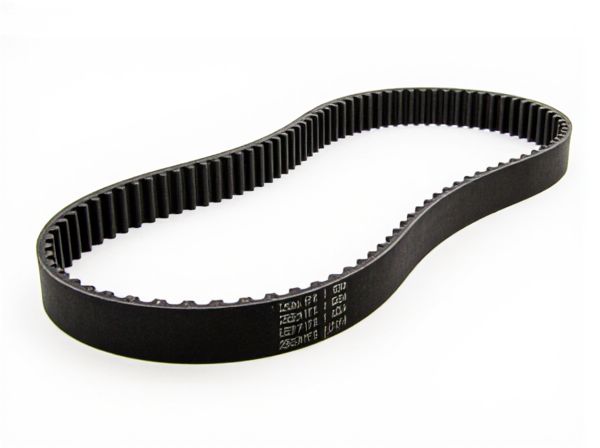
Photo illustration: Silent Timing Belt vs Conventional Timing Belt
Silent timing belts offer smoother and quieter engine operation compared to conventional timing belts, reducing noise and vibration. They are designed with advanced materials and tooth profiles that enhance durability and precision in timing. Your vehicle benefits from improved performance and extended belt life with a silent timing belt.
Table of Comparison
| Feature | Silent Timing Belt | Conventional Timing Belt |
|---|---|---|
| Noise Level | Low noise, smooth operation | Higher noise due to friction |
| Durability | High durability, resistant to wear | Moderate durability, prone to wear |
| Material | Advanced composite materials | Rubber with fiber reinforcement |
| Maintenance | Longer service intervals | Frequent inspections required |
| Cost | Higher initial cost | Lower initial cost |
| Performance | Stable timing, improved engine efficiency | Basic timing performance |
Introduction to Timing Belts
Timing belts are crucial components in internal combustion engines, synchronizing the rotation of the crankshaft and camshaft to ensure precise valve timing. Silent timing belts use advanced materials and tooth designs, such as polyurethane and nylon coatings, to reduce noise and vibration compared to conventional rubber timing belts. These improvements enhance engine durability and provide a quieter driving experience without compromising performance.
Overview of Silent Timing Belts
Silent timing belts utilize advanced materials and precise tooth profiles to significantly reduce noise and vibration during engine operation. These belts feature polyurethane or high-quality rubber compounds reinforced with fiberglass or Kevlar cords to enhance durability and flexibility. Compared to conventional timing belts, silent timing belts offer improved performance, longer service life, and quieter engine function, making them ideal for modern high-performance and luxury vehicles.
Conventional Timing Belts Explained
Conventional timing belts, typically made from rubber reinforced with fiberglass or Kevlar, provide reliable engine synchronization by connecting the crankshaft to the camshaft. These belts require regular maintenance and replacement every 60,000 to 100,000 miles to prevent wear-induced engine damage. Despite being noisier than silent timing belts, conventional belts remain a cost-effective choice for many internal combustion engine vehicles.
Key Differences Between Silent and Conventional Timing Belts
Silent timing belts feature a specially designed tooth profile and use advanced materials like polyurethane to minimize noise, whereas conventional timing belts typically use rubber and a standard tooth design that generates more sound during operation. Silent timing belts provide smoother engine performance and longer service life due to reduced vibration and wear, making them ideal for high-performance and luxury vehicles, while conventional belts are cost-effective and sufficient for regular driving conditions. Key differences include noise level, material composition, durability, and overall impact on engine smoothness and efficiency.
Noise Reduction Capabilities
Silent timing belts utilize advanced materials and design features, such as polyurethane teeth and a tensioner system, to significantly reduce engine noise compared to conventional timing belts made of rubber and fabric. These belts operate more smoothly and absorb vibrations, leading to a quieter engine performance ideal for luxury vehicles and noise-sensitive environments. Noise reduction capabilities of silent timing belts enhance driving comfort by minimizing the characteristic whirring and rattling sounds common with traditional belts.
Performance and Efficiency Comparison
Silent timing belts feature advanced materials and tooth profiles that reduce noise and vibration, enhancing engine smoothness compared to conventional timing belts. Their improved design minimizes friction and wear, resulting in better fuel efficiency and longer service life. Conventional timing belts, while reliable, typically generate more noise and may require more frequent maintenance, affecting overall performance and operational efficiency.
Durability and Lifespan
Silent timing belts, made from advanced materials like reinforced rubber and durable polymers, typically offer enhanced durability compared to conventional timing belts, reducing wear and tear under extreme conditions. Their design minimizes vibration and noise, contributing to a longer lifespan that often exceeds 100,000 miles, whereas conventional timing belts usually require replacement between 60,000 to 90,000 miles. Maintenance intervals for silent timing belts tend to be extended, making them a preferred choice for high-performance and modern engines seeking reliability and reduced service frequency.
Maintenance Requirements
Silent timing belts require less frequent maintenance due to their advanced materials and design, which reduce wear and noise. Conventional timing belts need regular inspection and replacement at shorter intervals, typically every 60,000 to 100,000 miles, to prevent engine damage. Proper maintenance of silent belts can extend service life beyond 100,000 miles while minimizing the risk of failure and costly repairs.
Cost Considerations
Silent timing belts typically have a higher upfront cost compared to conventional timing belts due to advanced materials and design that reduce noise and vibration. Despite the initial expense, silent belts often offer longer service life and lower maintenance costs, potentially providing better overall value. Conventional timing belts are generally less expensive initially but may require more frequent replacements and labor, increasing long-term expenses.
Choosing the Right Timing Belt for Your Vehicle
Silent timing belts feature advanced materials and design to reduce noise and vibration, enhancing engine performance and longevity. Conventional timing belts, while reliable and cost-effective, may produce more noise and require more frequent replacement intervals. Choosing the right timing belt depends on your vehicle's make, model, driving conditions, and budget, with silent belts often favored for modern, high-performance engines seeking quieter operation and extended durability.
 caratoz.com
caratoz.com